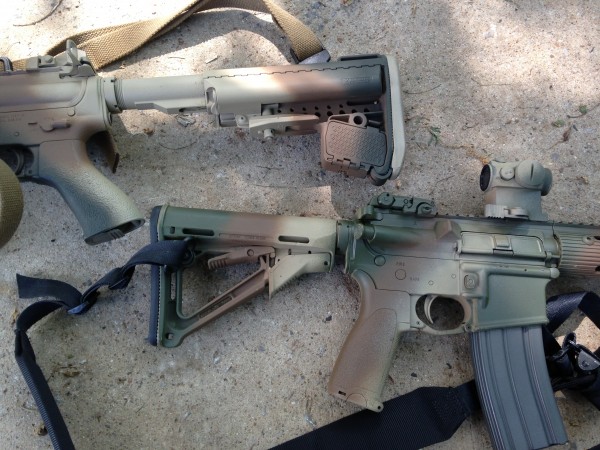Every so often certain techniques seem to swap around in the shooting community. Almost like this week the Surgeon General says that salt is good for you, where last week salt was bad for you. The whole stock in or stock fully extended thing seems to follow it pretty closely.
In the late 1990’s, it seemed to be all the rage to run the collapsible stock all the way collapsed. The train of thought was that you could place the stock on the inside of the straps of your body armor. It also assisted you in one handed shooting, and lessened the arc of movement between shooting from either shoulder as the problem required.
Today there seems to be a great push to run the stock all the way out. The idea behind it is that the stock all the way out give you better leverage on the gun. The added benefits is that when you go prone you don’t have to extend the stock out to mount the gun properly. If you look at all the guys that shoot 3 Gun for a living, they are running the stock all the way out to gather that extra leverage.
My personal belief is this. Neither are correct for every rifle, and every shooter.
Some of my rifles I can get away with running the stock fully extended. Some of my rifles I have to run them one click in. I’ve observed students who simply can’t run the stock all the way out. I think that the individual shooter should practice so basic core drills like one and two shots from the low ready, one and two shots from the high ready, and a Bill Drill or two. Based upon what their dot track and gun handling are doing, they can adjust the stock one click in or out depending up their needs.
I do think that running the stock further out has benefits that can’t be denied. It just isn’t one sized fits all………




Hence, the reason we use adjustable stocks. 🙂
After hearing Frank Proctor explain and show in a video how leverage on the rifle works and helps the shooter, I’m a full believer in running the stock out as far as you can. I generally try to run the stock at the 5 position (on a 6 position buffer tube) and that seems to work well for me. I think the most important thing is, once you get the stock were you like it, DON’T TOUCH IT. Moving the stock back and forth changes your head position on the rifle which leads to inconsistency. The key marksmanship is consistency so you need to doing the same thing every single time to get the results you want. Changing your stock and head positions all the time is just working against you.
Same here from my time with Frank. But as you said “as far as you can”. Which is actually where Jerry left it more or less. I like it shorter when scrunched up in a hide waiting to ambush a deer as I inevitably have to contort some direction in colder weather gear where the shorter is more versatile. It depends.
Must run stock in middle position…
I generally keep mine set in the middle “Warsaw” notch while not in use. That way, when I pick it gets picked up, it’s the perfect length for my wife, and still usable by me regardless of whether I’m wearing light or heavy clothing. Then I adjust the stock as needs dictate and time allows.
One size does not fit all. So much depends on physique/equipment/situation.
Kind of like how different people will necessarily place their finger differently on a trigger, due to different hand size, thickness, finger length, etc.
My method for my patrol rifles.
-Fully closed to fit in vehicle locking rack
-2 clicks out for patrol uniform
-1 click out for plate carrier/armor carrier
YMMV
I prefer a long stock, maybe one click in for longer stocks like a vltor or sopmod, standard M4 stocks I need all the way out though. I do find that having a longer stock makes using night vision a lot easier, you bang your pvs14 on the optic a lot less.
This is like situational leadership; it all depends. On a high-percentage, distant shot, with low danger to me, yes, extend the stock, sling up and get into a good kneeling or prone position. Grabbing the rifle out of the rack in the squad, charging it and laying the hate at 10-15 yards, I would just leave it collapsed. Ideally, I prefer it one notch out for clearing structures.